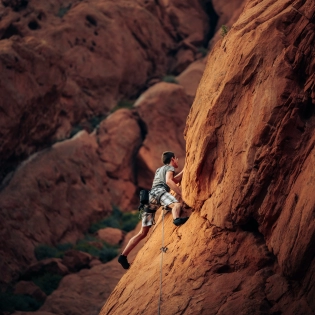







Climbers Point
Rock climbing strengthens your body in various ways. It primarily develops upper body strength as you pull and hold your body weight using your arms, shoulders, and back muscles. Climbing also engages your core muscles to maintain balance and stability. Holding onto rock holds improves grip strength, benefiting your forearm and hand muscles. Additionally, climbing challenges your muscles to sustain effort, improving overall muscular endurance. While lower body strength is not the main focus, leg muscles also play a role in supporting your movements during climbs.
Yoga can benefit rock climbing in multiple ways:
-
Flexibility: Yoga improves flexibility, aiding climbers in reaching holds and performing movements more effectively.
-
Strength and Stability: Yoga poses strengthen muscles, enhancing overall body strength and stability, which translates to better control and balance while climbing.
-
Body Awareness: Yoga cultivates body awareness, helping climbers better understand their body positioning and movements, leading to improved technique and efficiency on the wall.
To help prevent finger injuries from recurring in rock climbing, here are a few tips:
- Warm-up: Always warm up your fingers and hands before climbing. Engage in light stretching exercises and gradually increase the intensity to prepare your tendons and muscles for the demands of climbing.
- Proper Technique: Focus on using proper climbing technique and body positioning. This includes using your lower body and core strength effectively, which can reduce excessive strain on your fingers.
- Gradual Progression: Avoid overexertion and progressing too quickly. Gradually increase the intensity and difficulty of your climbs to allow your fingers and tendons to adapt and strengthen over time.
- Finger Strength Training: Incorporate finger strength training exercises into your routine. This can include using fingerboards, hangboards, or grip strengtheners to improve finger strength and resilience.
- Rest and Recovery: Allow for proper rest and recovery between climbing sessions. Adequate rest helps your body repair and strengthen, reducing the risk of overuse injuries.
- Listen to Your Body: Pay attention to any signs of discomfort, pain, or fatigue in your fingers. If you experience any issues, it's important to address them promptly and seek appropriate rest and treatment as needed.
- Finger Care: Take care of your fingers by keeping the skin moisturized, avoiding excessive filing of calluses, and addressing any minor injuries or cuts promptly to prevent infections.
- Proper Gear: Ensure that you are using properly fitted climbing shoes and equipment that provide support and minimize stress on your fingers.
Remember, while these tips can help reduce the risk of finger injuries, it's important to listen to your body and consult with a healthcare professional or qualified trainer for personalized advice based on your specific needs and circumstances.
To help facilitate the healing process of a finger pulley injury, here are a few suggestions:
- Rest: Give your injured finger time to rest and avoid any activities that may aggravate the injury. Minimizing strain and allowing adequate recovery time is crucial.
- Ice: Applying ice to the injured area can help reduce swelling and inflammation. Use an ice pack or wrap ice in a thin cloth and apply it to the injured finger for about 15-20 minutes at a time, several times a day.
- Compression: Consider using compression bandages or finger sleeves to provide support and help reduce swelling. Be sure not to wrap too tightly, as it may hinder blood flow.
- Elevation: Elevating your hand and keeping it above heart level can assist in reducing swelling and promoting healing.
- Gentle Range of Motion Exercises: Once the acute phase of the injury has passed, gentle range of motion exercises, as recommended by a healthcare professional, can help maintain finger mobility and prevent stiffness.
- Gradual Rehabilitation: As your finger improves, gradually introduce strengthening exercises and gradually increase the intensity of your climbing or finger-specific training. However, it's important to consult with a healthcare professional or a qualified hand therapist before starting any rehabilitation exercises.
Remember, everyone's healing process may vary, and it's essential to listen to your body and seek guidance from a medical professional to ensure proper care and recovery.
Determining whether to resole your climbing shoes or buy new ones depends on a few factors:
- Sole wear: Check if the sole is significantly worn down or lacks grip.
- Performance: Pay attention to any decrease in sensitivity, precision, or grip during climbs.
- Structural integrity: Look for any damage, stretching, or holes in the shoe's structure.
- Personal preference: Consider if the shoes still suit your climbing style and if you desire any new features.
Considering these factors will help you decide whether to resole your shoes or invest in a new pair.
The number of times you can resole your climbing shoes depends on several factors, including the quality of the shoes, the type of climbing you do, and how well you maintain them. Generally, well-made climbing shoes can be resoled multiple times before they become too worn out to continue. It's not uncommon for climbers to resole their shoes two to four times, but this can vary.
It's important to note that the resoling process involves removing the old sole and attaching a new one, which can affect the shoe's fit and performance. With each resole, the shoe may undergo some changes, so it's crucial to choose a reputable resoler who understands the specific requirements of climbing shoes.
In rock climbing, it is absolutely acceptable to explore different beta and find alternative ways to climb a route or problem. Trying different sequences and experimenting with beta is a common practice and can be a valuable learning experience. It allows climbers to discover new techniques, adapt to their strengths, and find creative solutions to challenges.
While the intended beta provided by route setters can serve as a helpful guide, it is not a strict rule that must be followed. Climbers often bring their own unique skills, body types, and preferences to the climb, and finding personalized beta can be part of the enjoyment and growth in the sport.
So, feel free to try out different beta and find the method that works best for you. Climbing is an individual journey, and exploring different approaches can enhance your skills and make the sport more rewarding.
The lights on a Moon board are typically positioned under the holds to create a specific type of training environment. Placing the lights underneath the holds helps illuminate the climbing holds and highlights their edges, making it easier for climbers to identify and target specific holds during their training sessions. This setup enhances body awareness, improves accuracy in foot and hand placements, and allows climbers to focus on precise movements and techniques. By emphasizing hold visibility, climbers can effectively practice and develop their climbing skills on the Moon board.
As a climber, I can tell you that rock climbing itself doesn't necessarily make your hands bigger in terms of bone structure. However, consistent climbing can lead to increased muscle development in your hands and forearms, which can give the appearance of larger hands.
The repetitive gripping and pulling motions involved in climbing can strengthen the muscles in your hands and forearms, making them more defined and potentially bulkier. This can give the impression of larger hands, particularly in terms of muscle size.
Rock climbing is a mix of cardio and strength training. It requires strength to pull yourself up and hold onto the wall or rocks. At the same time, climbing can get your heart pumping and provide a good cardiovascular workout. So, it's a great way to build both strength and endurance.




